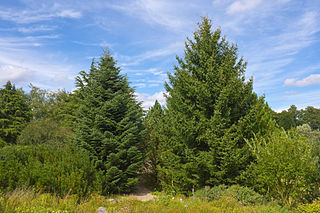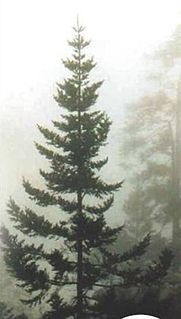
Firs (Abies) are a genus of 48–56 species of evergreen coniferous trees in the family Pinaceae. They are found through much of North and Central America, Europe, Asia, and North Africa, occurring in mountains over most of the range. Firs are most closely related to the genus Cedrus (cedar). Douglas firs are not true firs, being of the genus Pseudotsuga.

Abies nordmanniana, the Nordmann fir or Caucasian fir, is a fir indigenous to the mountains south and east of the Black Sea, in Turkey, Georgia and the Russian Caucasus. It occurs at altitudes of 900–2,200 m on mountains with precipitation of over 1,000 mm.

Pinus tabuliformis, also called Manchurian red pine, Southern Chinese pine or Chinese red pine, is a pine native to northern China from Liaoning west to Inner Mongolia and Gansu, and south to Shandong, Henan and Shaanxi, and also northern Korea. In some older texts the name is spelled "Pinus tabulaeformis".

Abies cephalonica or Greek fir is a fir native to the mountains of Greece, primarily in the Peloponnesos and the island of Kefallonia, intergrading with the closely related Bulgarian fir further north in the Pindus mountains of northern Greece. It is a medium-size evergreen coniferous tree growing to 25–35 metres (82–115 ft) – rarely 40 m (130 ft) – tall and with a trunk diameter of up to 1 m. It occurs at altitudes of 900–1,700 m (3,000–5,600 ft), on mountains with a rainfall of over 1,000 millimetres (39 in).

Abies grandis is a fir native to the Pacific Northwest and Northern California of North America, occurring at altitudes of sea level to 1,800 m. It is a major constituent of the Grand Fir/Douglas Fir Ecoregion of the Cascade Range.

Abies magnifica, the red fir or silvertip fir, is a western North American fir, native to the mountains of southwest Oregon and California in the United States. It is a high elevation tree, typically occurring at 1,400–2,700 metres (4,600–8,900 ft) elevation, though only rarely reaching tree line. The name red fir derives from the bark color of old trees.

Abies procera, the noble fir, also called red fir and Christmas tree, is a western North American fir, native to the Cascade Range and Coast Range mountains of extreme northwest California and western Oregon and Washington in the United States. It is a high-altitude tree, typically occurring at 300–1,500 m (980–4,920 ft) altitude, only rarely reaching the tree line.

The Fraser fir is a species of fir native to the Appalachian Mountains of the Southeastern United States.

Abies amabilis, commonly known as the Pacific silver fir, is a fir native to the Pacific Northwest of North America, occurring in the Pacific Coast Ranges and the Cascade Range from the extreme southeast of Alaska, through western British Columbia, Washington and Oregon, to the extreme northwest of California. It is also commonly referred to as the white fir, red fir, lovely fir, Amabilis fir, Cascades fir, or silver fir. It grows from sea level to 1,500 metres (4,900 ft) in the north of the range, and 1,000–2,300 m (3,300–7,500 ft) in the south of the range, always in temperate rain forest with relatively high precipitation and cool, humid summers. Common associate trees are western hemlock in northern ranges, Douglas fir in central areas, and in the extreme southern area of its range, California buckeye.

Abies mariesii is a fir native to the mountains of central and northern Honshū, Japan. It grows at altitudes of 750–1,900 m in northern Honshū, and 1,800–2,900 m in central Honshū, always in temperate rain forest with high rainfall and cool, humid summers, and very heavy winter snowfall.

Abies homolepis, the Nikko fir is a fir native to the mountains of central and southern Honshū and Shikoku, Japan. It grows at altitudes of 700–2,200 m, often in temperate rain forest with high rainfall and cool, humid summers, and heavy winter snowfall.

Larix sibirica, the Siberian larch or Russian larch, is a frost-hardy tree native to western Russia, from close to the Finnish border east to the Yenisei valley in central Siberia, where it hybridises with the Dahurian larch L. gmelinii of eastern Siberia; the hybrid is known as Larix × czekanowskii.

Abies koreana, the Korean fir, is a species of fir native to the higher mountains of South Korea, including Jeju Island. It grows at altitudes of 1,000–1,900 metres (3,300–6,200 ft) in temperate rainforest with high rainfall and cool, humid summers, and heavy winter snowfall.

Abies sibirica, the Siberian fir, is a coniferous evergreen tree native to the taiga east of the Volga River and south of 67°40' North latitude in Siberia through Turkestan, northeast Xinjiang, Mongolia and Heilongjiang.

Abies holophylla, also called needle fir or Manchurian fir, is a species of fir native to mountainous regions of northern Korea, southern Ussuriland, and China in the provinces of Heilongjiang, Jilin, and Liaoning.

Abies firma, the momi fir, is a species of fir native to central and southern Japan, growing at low to moderate altitudes of 50–1600 m.

Abies religiosa, the oyamel fir or sacred fir, is a fir native to the mountains of central and southern Mexico and western Guatemala. It grows at high altitudes of 2,100–4,100 metres (6,900–13,500 ft) in cloud forests with cool, humid summers and dry winters in most of its habitat regime. In the state of Veracruz, it grows with precipitation all year long. The tree is resistant to regular winter snowfalls.

Abies guatemalensis, the Guatemalan fir or pinabete, is an evergreen tree native to Central America and is the southernmost member of the genus Abies being spread to the south lower than 14° N. Its range is from southern Mexico in the north to Honduras and El Salvador in the south. It is a warm-loving and moisture-loving tree of the tropical mountain coniferous and mixed cloud forests of these countries. The Guatemalan fir is an almost completely non-frost-resistant tree. Due to logging and loss of habitat, the tree is considered threatened and is protected in CITES Appendix I.

Abies delavayi, the Delavay's silver-fir or Delavay's fir, is a species of fir, native to Yunnan in southwest China and adjoining border areas in southeastern Tibet, far northeastern India, northern Myanmar, and far northwestern Vietnam. It is a high altitude mountain tree, growing at elevations of 3,000–4,000 m, often occupying the tree line.

Abies vejarii is a species of fir native to northeastern Mexico, in the states of Coahuila and Nuevo León, where it grows at high altitudes in the Sierra Madre Oriental.





















